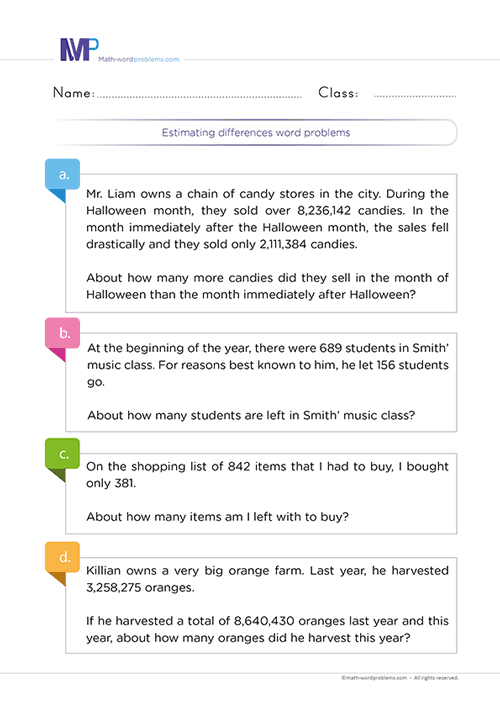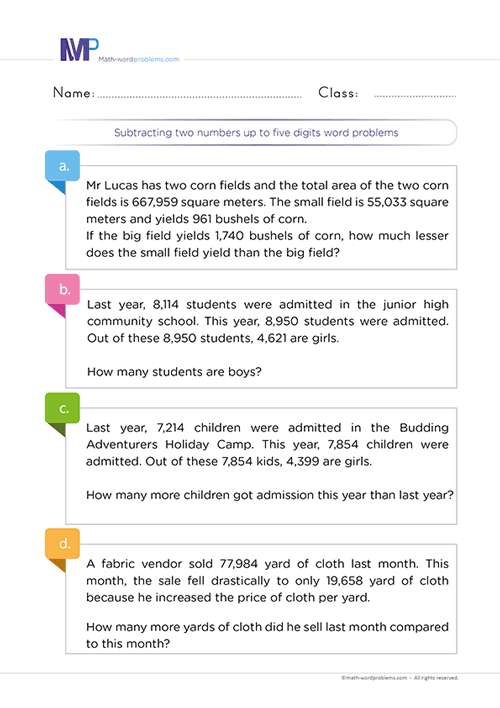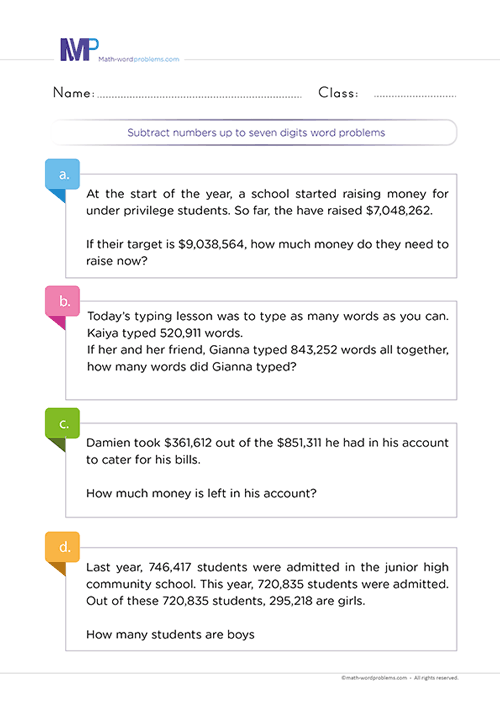 How to estimate differences word problems
How to estimate differences word problems
We have designed a remarkable guide on how to estimate differences in word problems, which will help fourth graders overcome the difficulties they face in handling problems.
Your kids will find this unique step-by-step guide on how to estimate differences word problems very helpful, considering how most of them face difficulties in solving estimation problems.
Most importantly, once kids start solving these remarkable problems with fun strategies, they will become talented and skilled in tackling complex or challenging word problems about estimating differences.
Steps to solve Estimation of Differences Word Problems
Our remarkable steps to solve estimation of differences word problems are short and straightforward to captivate kids' interest and eagerness to solve more estimation of differences problems, either simple and challenging
It is also interesting to note that this unique procedure of solving word problems will offer fourth graders genuine skills in tackling real-life problems that require estimating differences.
To this effect, we will include complex yet exciting real-life examples for your kids to follow through and learn how to estimate differences in word problems the easiest way.
Step 1- IDENTIFY THE PROBLEM:
To identify the problem, start by reading the word problem carefully, then highlight facts such as what the problem wants you to solve, numbers, and important keywords.
- Firstly, Suppose it is estimating whole numbers involving subtraction word problems. In that case, you will see at least one of the keywords below in the word problem: - less, minus, take away, left, decrease, difference, fewer, deduct, remain, change, how many more, leftover, less than, how much longer/shorter, how much more, fewer than, discount, etc.
- Secondly and most importantly, there are two ways to formulate or determine if a word problem requires you to estimate. If you find the words "about … "and "estimate …" in a word problem, then it is an estimation problem.
In addition to this, you have to take note of the following:
- Know and understand your place values.
- Know when to round up or down.
Note: One key Element for learners to understand is that they should not always rely on keywords alone. That is to say; the same keyword can have different meanings in different word problems.
For this reason, we reiterate on the importance of reading the question very carefully to understand the situation that the word problem is describing, then figure out exactly which operation to use
Step 2 – STRATEGIZE AND DETERMINE THE OPERATIONS:
Now, ask yourself, "how can I solve this problem?"
You must remember that each word problem may require a different format to solve it. Hence, the key points below will enable young math learners to tackle any format however it comes.
- First, the keyword in the word problem will help clarify the operation that you need to carry out.
- On the other hand, know that you must not rely merely on keywords. Also, try to understand the situation that the problem is describing.
- After knowing which operation you will perform, construct short expressions/sentences representing the given word problem. This visual representation of the most vital information will make it easier to solve the word problem.
Step 3 – SET UP A NUMBER SENTENCE AND AN EQUATION:
- After knowing which operation you will perform, construct short phrases to represent the given word problem. This visual representation of the most vital information makes it easier to solve the word problem.
- Then, write down a numerical equation representing the information given in the word problem.
Step 4 – SOLVE THE PROBLEM:
Now, after writing down the math problem (numerical equation), you can solve the problem using any subtraction method, preferably the column method. But before you do that, there are a few steps to follow when estimating or rounding.
- Firstly, look at the number to the immediate right of the digit to be rounded.
- If that number is 0−4, keep the digit (to be rounded) unchanged, then replace all numbers to the right of that digit with 0.
- But if that number is 5−9, increase the digit (to be rounded) by 1, then replace all numbers to the right of that digit with 0.
Finally, don't forget the unit of measurement, if any.
Step 5 – VERIFY YOUR ANSWER:
Finally, check your work to make sure that your answer is correct. Ask yourself this question. Does my answer make sense? If "YES," you are done. If "NO," go back to step 1 and start all over again.
Examples on how to perform estimation of differences word problems
Example One
Step 1:The important numbers here are 5,651,710 and 9,879,562. The keyword(s) found in the word problem is "how many."
Step 2:Next, ask yourself, "How can I solve this problem?" From the situation that the word problem describes and the keyword found in the word problem call for you to use a subtraction operation. Also, the phrase "about" shows that we have to estimate.
Step 3:Construct short phrases to represent the given word problem. Furthermore, write down a numerical equation representing the information given in the word problem.
But before you do that, there are a few steps to follow when performing estimation.
- Firstly, look at the number to the immediate right of the digit to be rounded.
- Then, if that number is 0−4, keep the digit to be rounded the same and replace all numbers to the right of that digit with 0
- But if that number is 5−9, increase the digit to be rounded by 1 and replace all numbers to the right of that digit with 0.
- Finally, don't forget the unit of measurement, if any.
- Total number of apples that he harvested last year and this year = 9,879,562.
- Number of apples that he harvested last year = 5,651,710
- Therefore, the estimated number of apples he harvested this year = The estimated total number of apples he harvested last year and this year – The estimated number of apples he harvested last year
9,879,562 - 5,651,710 ≈ 10,000,000 – 6,000,000 = ?
Step 4:From step 3 above, stack the values in the equation you formed so that their place values should line up. Then, go ahead and add the values. Also, do not forget to add the unit of measurement to the final answer.
So, he harvested about 4,000,000 apples this year.
Step 5:Finally, check your work to ensure your answer is correct. Ask yourself this question. Does my answer make sense? If "YES," you are done. If "NO," go back to step 1 and start all over again.
Example Two
Step 1:First, the important numbers here are 985 and 99. The keyword(s) found in the word problem is "left."
Step 2: Next, ask yourself, "How can I solve this problem?" From the keyword found in the word problem, it is evident that you have to perform a subtraction operation, and the phrase "about" shows that we have to estimate.
Step 3: Now, construct short phrases to represent the given word problem. Next, write down a numerical equation representing the information given in the word problem. But before you do that, there are a few steps to follow when estimating or rounding.
- Firstly, look at the number to the immediate right of the digit to be rounded.
- Then, if that number is 0−4, keep the digit to be rounded the same and replace all numbers to the right of that digit with 0
- But if that number is 5−9, increase the digit to be rounded by 1 and replace all numbers to the right of that digit with 0.
- Finally, don't forget to include the unit of measurement in your final result.
- Number of packets of crayons that I bought = 985.
- Number of packets that I have distributed = 99.
- Therefore, the estimated number of packets of crayons I was left with = the estimated number of packets of crayons I bought – The estimated number of packets I have distributed.
Since one of the addends has only three digits, you have to round it to the nearest hundreds and round the other addends with four digits to the nearest hundreds. We do this only in cases where the rounding place for each number is not specified
985 – 99 ≈ 1,000 – 100 = ?
Step 4:From step 3 above, stack the values in the equation you formed so that their place values should line up. Then, go ahead and add the values. Also, do not forget the unit of measurement, if any.
Since one of the addends has only three digits, you have to round it to the nearest hundreds and round the other addends with four digits to the nearest hundreds. We do this only in cases where the rounding place for each number is not specified
So, I was left with about 900 packets of crayons
Step 5:Finally, check your work to ensure your answer is correct. Ask yourself this question. "Does my answer make sense?" If "YES," you are done. If "NO," go back to step 1 and start all over again.






